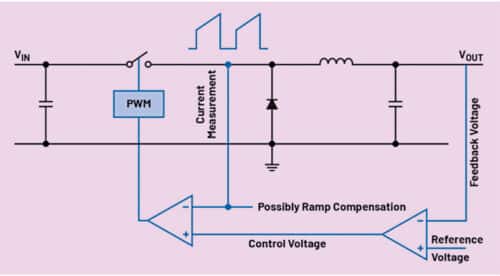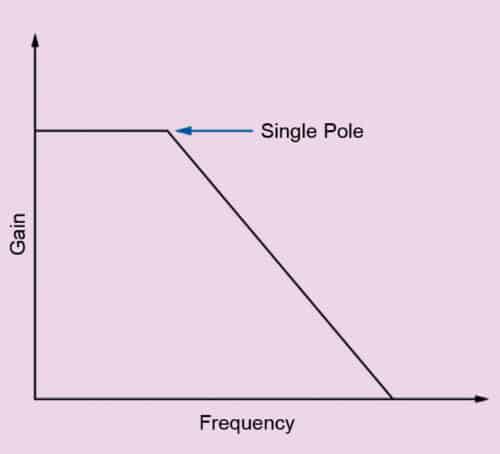There are thousands of different switching regulators on the market. Their election is based on specifications such as input voltage range, output voltage capability, maximum output current, and some other parameters. This article explains current mode, a differentiating feature commonly listed in data sheets, and its advantages and disadvantages.
The basic working principle of a current-mode regulator is shown in Fig. 1. Here, the feedback voltage is not only just compared with an internal voltage reference but also with a sawtooth voltage ramp for the generation of the necessary pulse width modulated (PWM) signal for the power switch.
The slope of this ramp is fixed in voltage-mode regulators. In current-mode regulators, the slope is dependent on the inductor current and is yielded from the current measurement shown in Fig. 1 at the switching node. This is what differentiates current-mode regulators from voltage-mode regulators.
Current-mode regulators offer many advantages. One is that the inductor current immediately adapts to changes in the input voltage (VIN in Fig. 1). Thus, the input voltage change information is directly fed into the control loop, even before the output voltage (VOUT in Fig. 1) tracks this input voltage change.

The advantages of current-mode control are so convincing that most switching regulator ICs on the market work according to this current-mode control principle.
Another key advantage is simplified control loop compensation. The Bode plot of a voltage-mode regulator shows a double pole; a current-mode regulator generates just one simple pole of the power stage at this point. This produces a phase shift of 90°, instead of 180° with a double pole. Thus, a current-mode regulator can be much more easily compensated and thus stabilised. Fig. 2 shows the simple transfer function of the power stage of a typical current-mode regulator.

However, a few disadvantages exist alongside the mentioned advantages. Current-mode regulators cannot immediately make the required current measurements after a switching transition because the noise will couple into the measurement strongly at this time. It takes a few nanoseconds for the noise caused by the switching to subside. This is called the blanking time. It normally results in a somewhat longer mini
mum on-time specification than for voltage-mode regulators.
Another disadvantage of current-mode regulators is the possibility, in principle, of a subharmonic oscillation. This is shown in Fig. 3. If a duty cycle of greater than 50% is required, a current-mode regulator may alternately execute short and long pulses. In many applications, this is considered instability, which should be avoided.

To solve this, a certain ramp compensation can be added to the generated current ramp shown in Fig. 1. It can shift the critical duty cycle threshold to well above 50% so that even at higher duty cycles, no subharmonic oscillations occur.
Even these earlier mentioned restrictions, due to the blanking time and the resultant duty cycle limitations, can be circumvented through the IC design. For example, one remedy is to incorporate low-side current sensing where the inductor current is measured during the off time rather than the on time.
All in all, the advantages of current-mode control in switching regulators outweigh the disadvantages for most applications. And through various circuit innovations and modifications, the disadvantages can be bypassed. As a result, most switching regulator ICs today use current-mode control.
Frederik Dostal has more than 20 years of experience in this industry. After working in National Semiconductor since 2001, he joined Analog Devices in 2009, where he held various positions, and currently works in the ADI office in Munich, Germany as a power management expert





